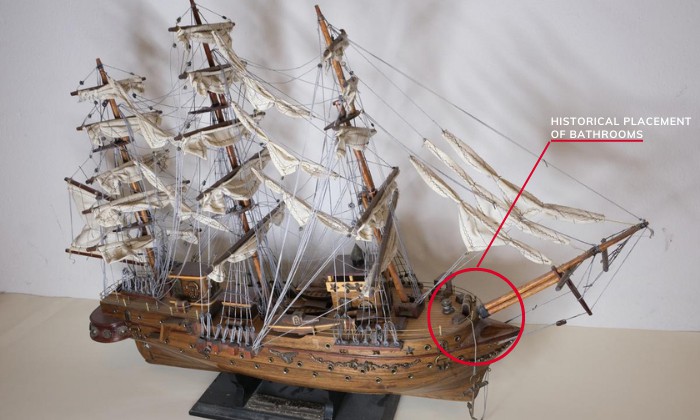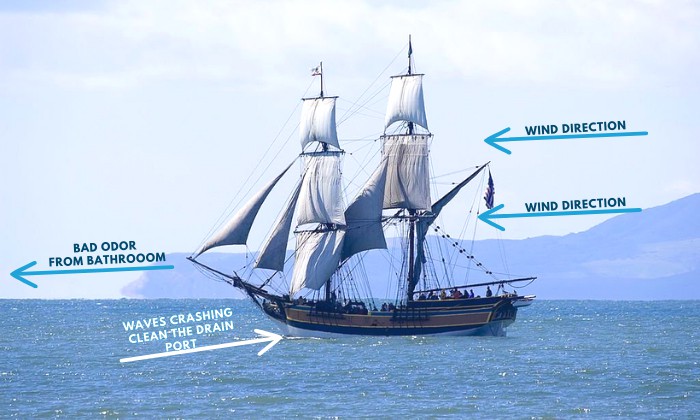As you may have wondered “why is a boat bathroom called a head?”, the term “head” for a boat bathroom may seem puzzling at first glance.
Well, the reason is simply because of the bathroom’s original placement at the head or the bow of a sailing vessel.
This classic boat head meaning for a bathroom has been around for a long time and is still extensively used in both the US Navy and the Royal Navy.
So, read on to delve into this nautical terminology, where intriguing history awaits your exploration.
A Nautical Riddle: The Origin of “Head”
The fascinating answer lies in the historical placement of bathrooms on sailing vessels. Traditionally, they were often situated at the front, known as the bow or fore of the boat.
But wait, shouldn’t it be referred to as the “bow” then? Although the ship’s front is indeed called the bow, the term “head” found its way into nautical bathroom slang due to historical facts.
Firstly, the head of a ship is originally called the term “heafod” meaning leader or chief in Old English. It’s where important decisions are being made with the whole crew as well as their living spaces, including toilets.
However, it’s not just because the bathroom is at the head of a boat. The head bathroom origin also fits in with another classical component of a watercraft.
The association of “head” with bathrooms also intertwines with another classic element of watercraft: the “figureheads.” They’re also positioned at the bow, and certain sailors believed these sculptures brought good luck and fortune to their voyages.
Still, it’s not entirely clear who exactly made that designation, though. We can surmise that it’s because nautical terminology and language tend to be directional in nature.
For example, sailors might exclaim, “The ship’s heading for the dock’s starboard side,” or “I’ll keep an eye out at the bow.” It’s a language embedded in their maritime souls.
Similarly, almost any trained sailors will say, “I will go to the head” because what they mean by the term is that they’re going to the area where it’s located – at least, in the past. Thus, the nautical term “head” remains to be used that way to this day.
Why at the Fore, Though?
Besides the question, “Why do they call the bathroom the head?”, it’s also worth looking at why they’re placed there in the first place.
Well, toilets on old sailing ships were strategically positioned there because they weren’t power-driven yet. If builders had put the bathroom at the stern, then the wind will only end up blowing all the excrement and bad odor toward the deck or cabins.
And so, unless you’re a poor sailor who sails directly against the wind, it’s only logical to put toilets in front to blow all those undesirables away while the waves crashing on the bow can clean the drain port.
And much like most naval traditions, it has stuck even though most modern vessels, assuming they’re large enough to accommodate a bathroom, now have the freedom to put them in other locations.
This could not be more evident in plenty of higher-end yachts out there that can be designed with spacious bathrooms put on the aft side of the watercraft. I’d be more than willing to bet that its captain and crew will still refer to it as the “head” if asked, though.
Conclusion
So, the next time someone asks “Why is a boat bathroom called a head?”, gently point out that it’s a naval term. Tell them that it’s just because toilets on old watercraft tend to place them at the front side of the ship. It’s really that simple.
For all this topic’s amusing touch, we can’t deny the richness of nautical language and colloquialism.
It affirms the industry’s long history and close-to-unyielding adherence to tradition. If we think about it, the naming decisions of various parts and locations of a ship have always had their quirks.

“My intention from the first day establishing Boating Basics Online is to provide as much help as possible for boaters who want to experience a first safe and convenient trip. So feel free to join us and share your beautiful journeys to the sea!”



